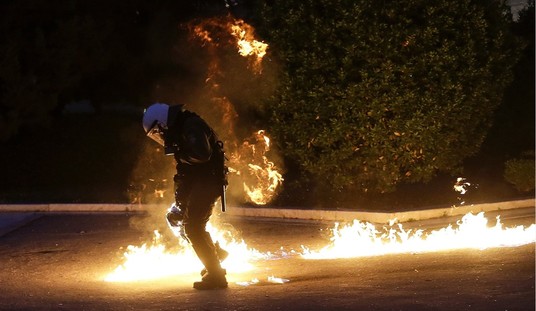Armond White of the New York Press, detractors have noted, seems to think he is the only real film critic in America. They may well be right, but probably so is he, and the Press’ house contrarian deserves thanks from all self-respecting cinephiles for doing the one thing most (perhaps all) other American film critics either refuse to do or are incapable of doing. Whether one disagrees with White or not, and almost everybody does at one point or another, there is no question that, whatever he writes, he is always thinking about cinema. What it is. What is can do. What it means. This is not much in the tradition of American film criticism, which has mostly been the domain of frustrated literary or theater critics, and sometimes simply the cub reporter nobody knows what to do with. It is far more in line with the extraordinary legacy of French film criticism, especially the avatars of the nouvelle vague like Francois Truffaut and Jean-Luc Godard, who later became groundbreaking filmmakers in their own right.
The great insight of the French film critics was that all cinema says something about cinema, even the usually dismissed movies like Hitchcock’s thrillers and Hollywood B-movies. But they did not hold simply that a B-movie could be great while an A-movie could be bad, but that all movies have something to say about cinema, and sometimes the B-movie can say something far more important and profound than an A-movie. White, it seems to me, writes according to this dictum, while most of his colleagues, if they ever encountered it, would probably have no idea what it means.
Foremost among these is unquestionably Chicago Sun-Times columnist, longtime television star, and all around face, voice, and personification of American film criticism, Roger Ebert. The bulbous, disconcertingly cherubic Ebert is unquestionably the most famous and probably the most successful movie reviewer in American history. Recently stricken with cancer and horribly deformed by a botched operation, and embraced, as a result, by America’s high priestess of the banal, Oprah Winfrey, Ebert and his legacy are now on the verge of being all but canonized.
It has been left to Armond White, unsurprisingly, to tell the truth about that legacy. “I do think it is fair to say,” /Film quotes him as saying, “that Roger Ebert destroyed film criticism.”
Because of the wide and far reach of television, he became an example of what a film critic does for too many people. And what he did simply was not criticism. It was simply blather. And it was a kind of purposefully dishonest enthusiasm for product, not real criticism at all. … I think he does not have the training. … Ebert just simply happened to have the job. And he’s had the job for a long time. He does not have the foundation. He simply got the job. … Often he wasn’t practicing criticism at all. Often he would point out gaffes or mistakes in continuity. That’s not criticism. That’s really a pea-brained kind of fan gibberish.
White is, as usual, both undiplomatic and entirely correct. Indeed, his final point is eminently born out by Ebert’s scathing review of the silly but quite enjoyable Transformers: Revenge of the Fallen, a film which the critical establishment, for unknown reasons, decided was a threat to human civilization. “Hello!” Ebert informs us in his standard eighth-grade prose, “you can’t outrun an explosion,” as if this mattered at all in an action movie. Considering that Ebert claims (with his depressing predictability) that Citizen Kane is his favorite movie, one could just as easily point out that no one is actually in the room to hear Kane’s last words that set the whole film in motion. If someone says “Rosebud” in an empty room, does it still make a sound? Revenge of the Fallen is, of course, nothing like the equal of Citizen Kane, but the point is worth making, if only for the sake of illustrating the pedantic irrelevancy of Ebert’s observation.
Indeed, Ebert’s own writings on Citizen Kane provide some valuable insight into just how pedantic and irrelevant Ebert’s observations can be. Orson Welles, as many know, did everything in his power to downplay the significance of the Rosebud twist at the end of his film, and Ebert may well be deferring to this when he notes that “it explains nothing.” A few sentences before, however, he expended a large number of words telling us everything it does explain: “Rosebud is the emblem of the security, hope and innocence of childhood, which a man can spend his life seeking to regain. It is the green light at the end of Gatsby’s pier; the leopard atop Kilimanjaro, seeking nobody knows what; the bone tossed into the air in 2001. It is that yearning after transience that adults learn to suppress.” None of this awful pseudo-poetry amounts to much, and Ebert’s final missive that “it is remarkably satisfactory as a demonstration that nothing can be explained” is nearly incomprehensible, on a par with another of his insights, “A man always seems the same size to himself, because he does not stand where we stand to look at him.”
Ebert is, of course, partially correct in the most banal sense, in that Rosebud, as a simple plot point, is a symbol of lost innocence. But even the most challenged of viewers can realize this within a few seconds of the film’s final shot, and Ebert’s gibbering accomplishes little more than restating this at great length. And his one attempt at a deeper insight is quite simply wrong. The final images of Kane are clearly not a “yearning after transience,” but a lamentation on transience. There is never the slightest indication anywhere in Kane that transience is something to be desired, and the sense of a lost, lamented world is something that runs throughout all of Welles’s work, especially Kane’s immediate successor, the magnificent and mutilated The Magnificent Ambersons.
It is merely sad that Ebert cannot read his favorite film with any degree of accuracy. More problematic, however, is that the banality of his remarks robs his readers of any new insight into or appreciation for one of the most important and influential films ever made. Indeed, Ebert’s entire take on the film can essentially be summarized as follows: “Orson Welles made this movie when he was really young. It has very good photography. It’s all about trying to find out what Rosebud means. But in the end it doesn’t mean anything. Which is kind of a good thing.” This is a caricature, of course, but it is not much exaggerated, and it applies quite well to most of Ebert’s other writings on films both great and small.
To stay with Welles for a moment, Ebert provides a good example when he writes about the director’s last masterpiece, Chimes at Midnight (1965), a variation on Shakespeare’s Falstaff plays. “The scene of the battle of Shrewsbury is justly famous,” he writes. “It lasts fully 10 minutes, chaotic action at a brutal pitch, horses and men confused in smoke and fog, steel crashing against steel, cries of pain, desperate struggles, confused limbs caked in mud and blood, men falling exhausted or dead.” This is, again, accurate so far as it goes. It explains next to nothing, however, about what may be the greatest and certainly one of the most influential battle scenes ever filmed.
Welles shoots the battle mostly at eye level, with what often appear to be handheld cameras. Though set and costumed in the Middle Ages, most of it looks like newsreel footage, and while it is edited to appear to be chaos, it quickly becomes clear that it has been very carefully constructed in order to evoke a kaleidoscopic, subjective experience of battle. Watching it, one sees immediately what inspired the D-Day sequence in Saving Private Ryan, the opening fight in Gangs of New York, and even some of Peckinpah’s most famous set pieces. What it provides us, moreover, is a vision of the two faces of the origins of cinema. On the one side, a battle montage worthy of Eisenstein and Griffith; and on the other, in Welles’s intercuts of the plump Falstaff pratfalling his way out of danger, the physical comedy of Keaton and Chaplin. Welles’s genius in this scene, in other words, is to show us just how powerful cinema, at its proper extremes, can be, and always has been. In Ebert’s hands, however, it is merely a catalogue of badly described moments, given no meaning or context, and marked by such hideous deformations of grammar as “There was not something Falstaffian about Welles, there was everything.”
So long as we are on the subject of battle scenes, Ebert’s take on two films by the Japanese master Akira Kurosawa provides equally damning insights into the poverty of Ebert’s work. Describing the central battle scene of Kurosawa’s Ran (1985), a version of King Lear set in medieval Japan, Ebert informs us that Kurosawa “uses several static cameras to film the action, cutting between them; because his cameras don’t dart and whirl, we are not encouraged to think of ourselves as participants but as gods, observing, taking the long view here and then a closeup look.” This is not wrong, per se, but it ignores, quite stupefyingly, the most important distancing element in the sequence, which is that it contains no live sound for half of its running time. Instead, the silent images of carnage unroll with nothing behind them but an extraordinary rumbling dirge written by the modernist composer Toru Takemitsu. The live sound then returns with the report of a gunshot, and the viewer is suddenly thrown headlong into the chaotic noise of war. The sequence, in effect, provides us with an object lesson in how cinema can manipulate our perceptions, keeping us at arm’s length and then suddenly pulling us in, forcing us simultaneously to reckon with our reactions to the violent images Kurosawa is presenting, and to question our distance from them, a distance that is inherent in cinema itself.
Equally egregious is Ebert’s inscrutable indifference to the final sequence in Kurosawa’s Kagemusha (1980), perhaps the director’s greatest accomplishment. The film tells the true story of a thief who is used by a samurai clan to impersonate their dead warlord, the charismatic Lord Shingen. “At the end,” Ebert writes, “the son of the real Lord Shingen orders his troops into a suicidal charge, and their deaths are not only unnecessary but meaningless, because they are not on behalf of the sacred person of the warlord.” This is essentially all he writes about what is quite simply one of the greatest moments in cinematic history. The clan faces off against its enemies, who are dug in across the plain and armed with muskets. One by one, Lord Shingen’s son orders his army’s divisions, each named after one of the elements from Sun Tzu’s Art of War, into battle. They charge into the field. Gunfire erupts. But Kurosawa denies us a shot of the battle itself. After the last division is exhausted, a terrifying kettle drum rumbles on to the soundtrack. And then we see it: A sea of corpses. Wounded men and horses trying to raise themselves, stumbling, and falling in slow motion. An apocalyptic vision of horror and death. Kurosawa sustains the scene for several minutes, an eternity of screen time, until it is almost unbearable to watch. He ends, finally, on the thief, who has witnessed everything and now stumbles, white-faced, toward the fallen standard of the clan. He has finally become Lord Shingen, but he is Shingen’s ghost, there to witness the decimation of his army and his dreams of a united Japan. Through the simplest cinematic tools — nothing more than editing, picking and choosing what to show and when — Kurosawa denies us the vicarious excitement that usually accompanies cinematic battle scenes and instead forces us to confront the full horror of man’s ability to destroy himself. It is a transcendent scene, perhaps the greatest Kurosawa ever shot, and Ebert has little more to say about it than a banal, moralistic aside that is not much more insightful than telling us that you cannot outrun an explosion.
To be fair, it should be noted that Ebert’s career has not been entirely without merit. He championed Scorsese before it was fashionable, and has taken the occasional unpopular stand, most notably on behalf of Sam Peckinpah’s demented classic Bring Me the Head of Alfredo Garcia (1974) which occasioned one of Ebert’s few genuinely insightful remarks. “Courage usually feels good in the movies,” he writes, and he is right, “but it comes in many moods, and here it feels bad but necessary, giving us a hero who is heartbreakingly human — a little man determined to accomplish his mission in memory of a woman he loved, and in truth to his own defiant code.” Somewhat maudlin, perhaps, but an admirable sentiment nonetheless, and worth being reminded of.
Such moments are few and far between in Ebert’s work, however, and perusing it, one is struck throughout by what can only be described as a persistent inability — or perhaps refusal — to actually think about what he is watching, and to provide his readers with something more than a mere reiteration of events and a handful of apparently arbitrary judgments. Ebert’s theory of cinema in effect amounts to little more than “I liked this, I didn’t like that.” Or, perhaps, “This happened, and I liked it. Then this happened, and I didn’t like it.” This is cataloguing, not criticism, and while it may lend itself to the fast-food style of movie reviewing that assigns stars and a thumbs up or down, it abdicates entirely the role and responsibility of the critic, which is to discern what the object of his criticism is, what it says about itself and its medium, and what it says, also, about we who are witnessing it and the society that created it. Ebert has made pale and stumbling attempts at one or two of these things, and they merely serve to throw his limitations into ever more devastating relief. When it comes to America and it’s often fraught relationship with what may be its greatest art form, Roger Ebert is heard everywhere; but, ironically and unfortunately, he has proved to have remarkably little to say.









Join the conversation as a VIP Member